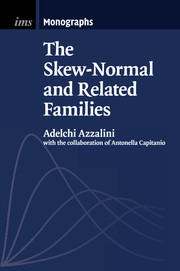Book contents
- Frontmatter
- Contents
- Preface
- 1 Modulation of symmetric densities
- 2 The skew-normal distribution: probability
- 3 The skew-normal distribution: statistics
- 4 Heavy and adaptive tails
- 5 The multivariate skew-normal distribution
- 6 Skew-elliptical distributions
- 7 Further extensions and other directions
- 8 Application-oriented work
- Appendix A Main symbols and notation
- Appendix B Complements on the normal distribution
- Appendix C Notions on likelihood inference
- References
- Index
4 - Heavy and adaptive tails
Published online by Cambridge University Press: 18 December 2013
- Frontmatter
- Contents
- Preface
- 1 Modulation of symmetric densities
- 2 The skew-normal distribution: probability
- 3 The skew-normal distribution: statistics
- 4 Heavy and adaptive tails
- 5 The multivariate skew-normal distribution
- 6 Skew-elliptical distributions
- 7 Further extensions and other directions
- 8 Application-oriented work
- Appendix A Main symbols and notation
- Appendix B Complements on the normal distribution
- Appendix C Notions on likelihood inference
- References
- Index
Summary
Motivating remarks
The skew-normal density has very short tails. In fact, the rate of decay to 0 of the density φ(x; α) as |x| → ∞ is either the same as the normal density or even faster, depending on whether x and α have equal or opposite sign, as specified by Proposition 2.8. This behaviour makes the skew-normal family unsuitable for a range of application areas where the distribution of the observed data is known to have heavier tails than the normal ones, sometimes appreciably heavier.
To construct a family of distributions of type (1.2) whose tails can be thicker than a normal ones, a solution cannot be sought by replacing the term Φ;(αx) in (2.1) with some other term G0{w(x)}, since essentially the same behaviour of the SN tails would be reproduced. The only real alternative is to adopt a base density f0 in (1.2) with heavier tails than the normal density.
For instance, we could select the Laplace density exp(−|x|)/2, whose tails decrease at exponential rate, to play the role of base density and proceed along lines similar to the skew-normal case. This is a legitimate program, but it is preferable that f0 itself is a member of a family of symmetric density functions, depending on a tail weight parameter, v say, which allows us to regulate tail thickness. For instance, one such choice for f0 is the Student's t family, where v is represented by the degrees of freedom.
- Type
- Chapter
- Information
- The Skew-Normal and Related Families , pp. 95 - 123Publisher: Cambridge University PressPrint publication year: 2013

